Mutant Future: Revised Edition by Ratpick
Preamble, or Why the Hell Am I Doing This Again?
Original SA post Mutant Future: Revised Edition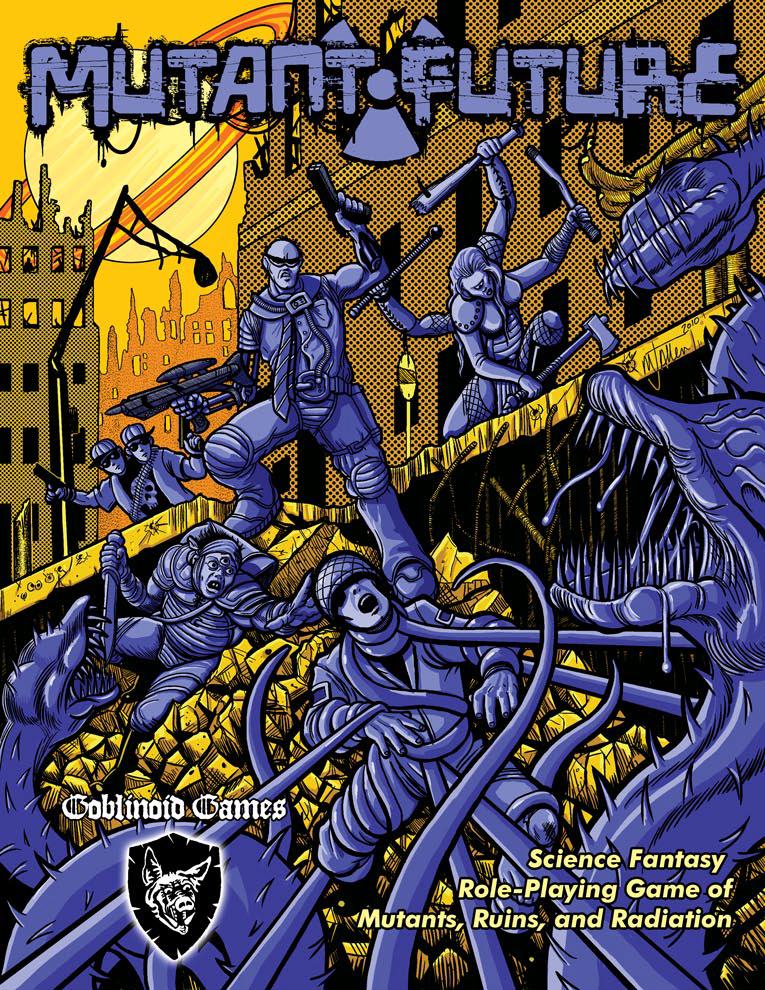
Preamble or: Why the Hell Am I Doing This Again?
quote:
The sinister and sadistic bleating of spidergoats echoes in the night, a complementary chorus to the rustling of an unfortunate victim caught in their webs. In deep, dank caves to the north, corrupted humans take communion with an unspeakably evil abomination they worship as a god. Shrill cries from the fields can only mean the vomit flies are back, molesting your livestock.
In short, just another day in the Mutant Future!
Mutant Future is an old-school post-apocalyptic science fantasy role-playing game by Daniel Proctor and Ryan Denison. The first printing, released in 2008, was very much its creators' labor of love, and it showed in many places: on account of not having many artists on the payroll, Proctor and Denison ended up using their own drawings and public domain images as illustrations for the book. This gave a lot of the first printing's a very misplaced quality.
The revised edition of Mutant Future, released in 2010, pretty much rectifies this. As you can see, the game now has brand spanking new cover art, and while the colors are very garish it does have a lot of personality. In addition to this most of the interior art is new, the game's rules have been clarified and fixed, and there's an entirely new section in the book titled Mutants & Mazes.
Before I get into the meat of Mutant Future, a short history lesson: Mutant Future is made by Goblinoid Games, the same company that brought us the Basic Dungeons & Dragons clone Labyrinth Lord. Apparently Proctor and Denison had wanted to do a retro post-apocalyptic RPG for ages and with retro-clones becoming such a big thing on certain parts of the internet, they decided to finally get around to it.
However, there was one problem: Gamma World 1e, the RPG they really wanted to clone, was not open gaming content, so doing a clone of Gamma World 1e would've been legally dubious. What the two realized then was that since the original Gamma World was basically D&D with the serial numbers filed off and the rules adapted to post-apocalyptic gonzo, they could do the same thing with Proctor's D&D clone, Labyrinth Lord.
So, what Mutant Future really is is a retro-clone of Gamma World by the way of Basic Dungeons & Dragons. As such, if you've ever played around with any of the numerous red boxes released in the 80s or are familiar with Basic via some of the retro-clones, this game shouldn't be too hard for you to grasp.
The game opens up with forewords by both Proctor and Denison. I'm not going to quote them in their entirety, but there are a few choice bits that really show the sort of mindset these two are coming from, as there's a lot of nice OSR anti-grog there:
Daniel Proctor posted:
I’ve heard from many people who are reluctant to give older play styles a chance, because their proponents are sometimes perceived as being too dogmatic, that is, too inflexible in adhering to “tenets” of out of print games. I want to communicate that Mutant Future and Labyrinth Lord have not been created as examples of how games “should be,” or even as a commentary on the way modern games have diverged from their roots. There is some debate about what degree modern games have gotten away from not just the rules of earlier editions, but also the “feel” or spirit of those games. This discussion is far too long to get involved in here, but it is my opinion that so long as you are having fun, it doesn’t matter which edition you are playing.
Ryan Denison posted:
Even though we haven’t been able to game together (we now live about 1,500 miles apart), we’ve spent some time over the last few years engaging in an activity we’ve dubbed “armchair role playing,” which is what happens when two gamer nerds drink boxed wine from Muppets glasses and begin long and involved conversations about how awesome it would be to live in the world of George Romero’s Night of the Living Dead, or argue over who would win in a fight to the death between a beaver-man and a robot, or whether or not the inclusion of cat-girls ruins a supposedly hard sci-fi gaming line. We only get to have these nerdly outbursts sporadically, but I savor every last one of them. They remind me that tabletop gaming is basically friendship with a zesty dose of zombies, beaver-men, and robots.
So, Mutant Future is a game written by two guys who don't think there is a one true way of gaming and who are painfully aware of the silliness of their hobby. That's pretty cool.
Next time, Introduction or: stuff that you should know already!
Section 1: Introduction
Original SA post
Mutant Future: Revised Edition
Section 1: Introduction
Okay, I'm going to breeze through this section, mainly because it's so short and so sparse on art. And speaking of art:
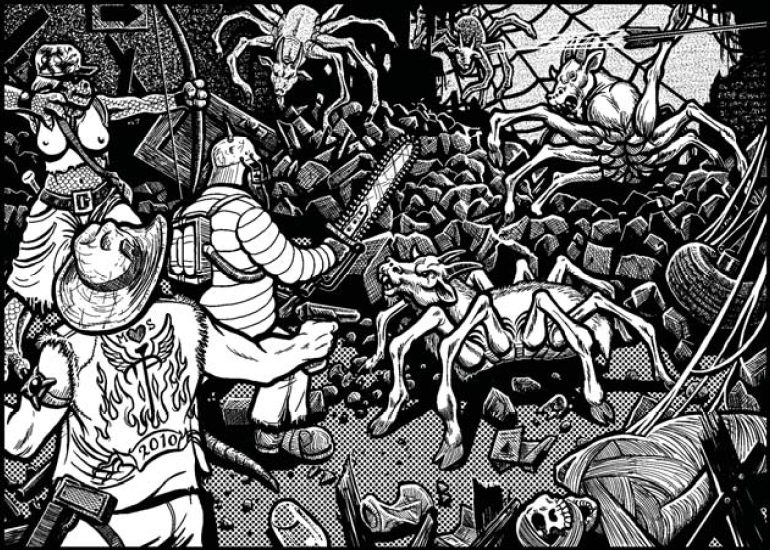
This is literally the first thing you see as you open the book.
Mutant Future begins with the traditional "What is Role-Playing?" section, which isn't particularly noteworthy. We are then told that while at the moment we are still boring level 0 humans, by simply creating a character we will immediately advance to 1st level! So, that's nice.
We are then told about the basics of Mutant Future. An undetermined apocalyptic event (the standard assumption is nuclear war) has completely destroyed human society and everything is covered with radiation. In real life this would probably lead to most life on earth dying off, but thankfully we are in science fantasy territory (as the book points out) so the worst that one can expect to happen from a bit of radiation is to become a totally kick-ass mutant.
Society before whatever destroyed the entire world was very futuristic, so basically on the same technological level as you would see in old sci-fi and B movies (i.e. laser guns, mechanical armor, cloning tanks, cyborgs), but most of said technology is now lost. The default technological level of Mutant Future is medieval, with ancient technology occupying the same niche as magic items in a traditional fantasy RPG.
Following this we have some discussion on dice and notation, which is what you'd expect. Then we get this:
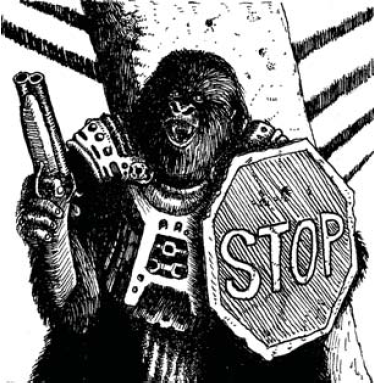
This could be your character.
This is followed by some discussion of terms. Of note is the fact that Mutant Future, like all good old-school RPGs, has two distinct units for measuring game time: turns (equal to ten minutes, which is your basic unit for time spent while exploring ruins) and rounds (equal to ten seconds, being your basic unit for time spent in combat). The game also mentions that the most common sources of XP in the game are monsters and treasure. So, we're doing the XP=gp thing here. We're also introduced to hp , which are tied directly to the character's Constitution ability score (and this will become relevant later on, as this is one of the facts that Purple XVI got wrong in their write-up of Mutant Future).
We also get a short discussion on encounters , which are special situations in which your characters interact with NPCs and monsters. It is pertinent to mention at this point that Mutant Future's approach to encounters is very old-school: encounters seem to happen in some types of alternate realities in the game. If you've ever played a Final Fantasy game, you know what I'm talking about. You're walking along in the ruins of a city when suddenly
 there is an encounter as
there is an encounter as

 3 spidergoats appear
3 spidergoats appear
 30 yards away from you and
30 yards away from you and
 they are hostile and
they are hostile and
 you are surprised. Now the game goes from exploration time to combat time so we can find out how many of you die of instant death poison.
you are surprised. Now the game goes from exploration time to combat time so we can find out how many of you die of instant death poison.
Personally, I like the fact that old-school games have these types of obviously gamey mechanics as I think they lend to lots of unforeseen and potentially funny outcomes, and it's also fun to watch grogs wax prosaic about how random encounters and wandering monsters are the epitome of Gygaxian naturalism and verisimilitude when the mechanics are so obviously gamey. The fact that encounters just randomly seem to pop out of nowhere on a random chance at random intervals makes it all the more ironic that 4e usually bears the brunt of accusations of being like a table-top video game.
Anyway, this post is getting long and I'm starting to ramble. Next time, Characters or: How I Learned to Stop Worrying and Love 3d6 in Order!
Section 2: Characters
Original SA post
Mutant Future: Revised Edition
SECTION 2: Characters
This section covers the basics of character creation in Mutant Future. The first thing to do is to get yourself a character sheet. The game has a hyperlink to http://www.mutantfuture.com a site which is apparently currently under construction. Huh. Thankfully, there's one available on Goblinoid Games' website !
Do you have your character sheets in hand now? Okay, the next thing to do is to roll 3d6 in order for each ability score, those being Strength, Dexterity, Constitution, Intelligence, Willpower and Charisma. So, basically your average D&D stats but for the fact that Wisdom is replaced by Willpower. The game also points out that some Mutant Lords (the Mutant Future name for GM) may let you roll 4d6, dropping the lowest, or even allow you to choose which of your abilities gets which roll.
However, I'm rolling old-school: 3d6 in order, here we go!

Strength 10, Dexterity 8, Constitution 12, Intelligence 10, Willpower 6, Charisma 13
We also get 3d8*10 gp to start with. Wait, gp? Whatever, let's just roll. Our character has 220 gp to begin with.
Figuring out modifiers is the next part. Anyone who is familiar with Basic D&D will know that Basic was one of the first games in the D&D line to have a sort of unified progression of ability modifiers, being as follows:
code:
3 -3
4-5 -2
6-8 -1
9-12 0
13-15 +1
16-17 +2
18 +3Constitution, oddly enough, doesn't simply modify your hit die rolls. No, your Constitution SCORE determines how many hit dice you get at level 1! Your hit die type depends on your race, which we'll get to in a minute.
Intelligence modifies your chances of figuring out ancient technology, with the modifier being your standard modifier multiplied by 5%. So, percentile rolls for technology, gotcha.
The only ability that doesn't have a table of modifiers is Willpower. We're only given an explanation that it's used for mental attacks, but we don't get an explanation of mental combat yet. Supposedly it's hidden somewhere in the combat section.
So, with that context we now know that my character is rather bog-standard but for a few things: he's a bit clumsier than average, quite weak-willed, yet somewhat charming. We now move on to the section of races.
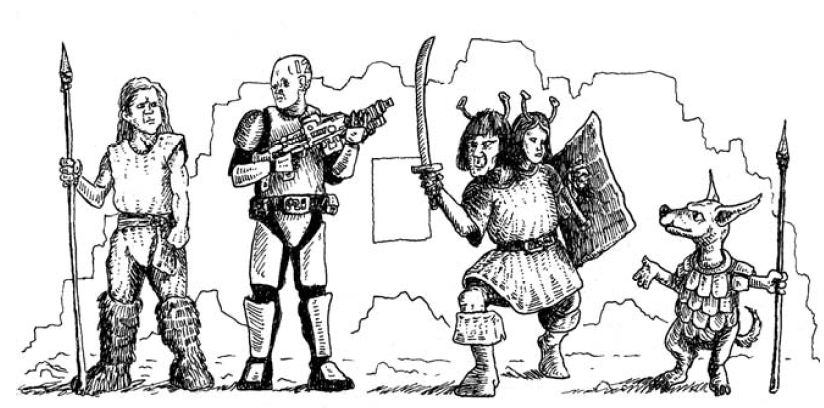
From left to right: Pure Human, Android, Mutant Human, Mutant Animal
That there picture shows some of the possible races of Mutant Future. For those of you who read Purple XVI's analysis of the first printing, you may notice that the picture is different. It's also terrible, mainly because it doesn't have a spidergoat, but also because there's no mutant plants to be seen. Thankfully, checking ahead a few pages reveals that mutant plants are still in the game.
So, the character types. There's Androids, which come in three types: Basic Android (which are humanoid robots), Synthetics (humanoid robots with mechanical functions that mimic biological processes) and Replicants (synthetic humanoids created in vats from DNA). The common thread between all Androids is that they only receive a set amount of mutations, but they can only gain beneficial mutations. In addition to this, Basic Androids and Synthetics start with a static 50 hp, but they do not heal naturally, instead requiring repairs. Replicants have 1d6 hit die, meaning that they start with a whooping average of 37 hp.
Mutant Animals and Mutant Humans are basically the same race. The only differences, literally, are the fact that Mutant Animals get a natural weapon (roll 1d6 to determine how powerful it is!) and that Mutant Humans have somewhat more favorable reaction modifiers from other races. Other than that, they get 1d4 mutations in both the physical and mental categories, meaning that on average they will have 5 mutations in total. They have 1d6 hit die, meaning that they are on the same level as replicants as far as toughness goes.
Mutant Plants are basically the same as Mutant Humans, except that they get 2 mutations from the plant category, getting a further 1d6 extra mutations from the human/animal categories, divided evenly. Other than that, virtually the same as Mutant Humans.
Pure Humans are boring. They sacrifice the ability to get mutations (as in, they can never get them, even as part of exposure to radiation) for a +3 increase to Constitution, Intelligence and Charisma and a 1d8 hit dice. While Constitution can never exceed 18 at character creation, Intelligence and Charisma can go as high as 21. These bonuses make Mutant Humans generally the toughest race in Mutant Future (since they will have on average 60 hp) and the most capable of figuring out ancient technology, but who wants that when there's a possibility of gaining totally sweet animal mutations?
So, while there's a huge urge to make my character a Pure Human for the bonuses, I decide to go with Mutant Animal for extra randomness. A bit of rolling reveals that I will get 1 physical and 3 mental mutations, and my natural weapon deals 1d6 points of damage. Rolling my hit points gives me 35 hp. Hooray!
The next section is alignment. Yes, Mutant Future uses old-school D&D three-point alignment (Law, Neutrality, Chaos). It feels really out of place and unnecessary in Mutant Future, so we'll just skip that for now.
Equipment comes next, and this is the part that shows the most clearly that Mutant Future is a Labyrinth Lord derivative. What I mean is that the equipment section is completely copy-pasted from Labyrinth Lord.
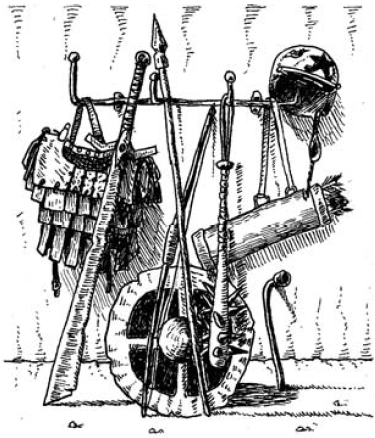
Okay, the bicycle helmet is a nice touch.
I guess it makes sense when you take into account the fact that human society has supposedly collapsed to a medieval level, but it just feels extremely lazy. Also, the idea of the standard currency being gold coins is equally jarring. I guess converting all the prices to bottlecaps or some other more post-apocalyptic form of coinage wouldn't be that big a deal, but it's just generally a very disappointing section.
Or it would be if it weren't for this badass mo-fo at the end:
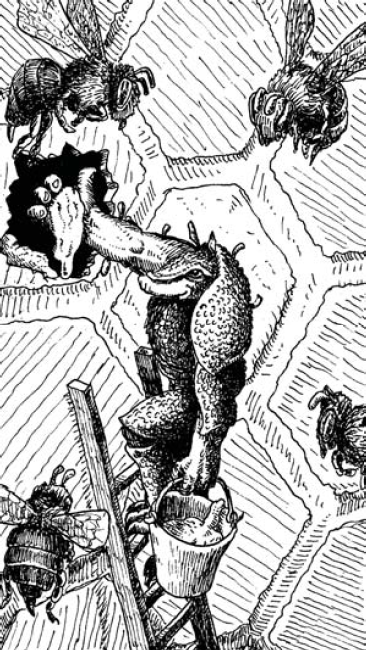
And if you're wondering why I think this is badass, remember: those bees probably have instant death poison.
Next time we'll finish up character creation with the best part of Mutant Future: random mutations!
Section 3: Mutations
Original SA post
Mutant Future: Revised Edition
SECTION 3: Mutations or: Psychic Hemophiliac Albino Dwarves
Mutations are pretty much the bread and butter of Mutant Future. Since there's very little to distinguish characters beyond ability scores and character type, mutations are the most important part of character creation. Unless you've chosen to play a pure human, in which case you probably should look towards a nice boring job in accounting. Seriously, why are you playing a pure human and thus missing out on the best part of the game?
Mutations are rolled for randomly, with the assumption being that characters with random mutations have picked those mutations through being of a very strange mixed pedigree. There is a caveat that players of mutant animals and plants can request to play a certain breed of animal or plant and thus be able to choose their own mutations, but this is left up to Mutant Lord discretion. Basically, if you want to play a mutant hedgehog and your Mutant Lord is a cool guy, they would probably let you have Spiny Growth as a mutation.
There are three distinct lists of mutations to roll from. Mutant animals and humans roll randomly for 1d4 physical and mental mutations on the respective lists, mutant plants get two random plant mutations and 1d6 mutations from the animal/human lists (divided equally between physical and mental, with the player allowed to choose from which list they wish to roll any odd mutation), and androids get 3 mutations from their choice of physical and/or mental. Androids can't have drawbacks, which more than makes up for the fact that they get fewer mutations on average, as will become apparent when you look at the lists:
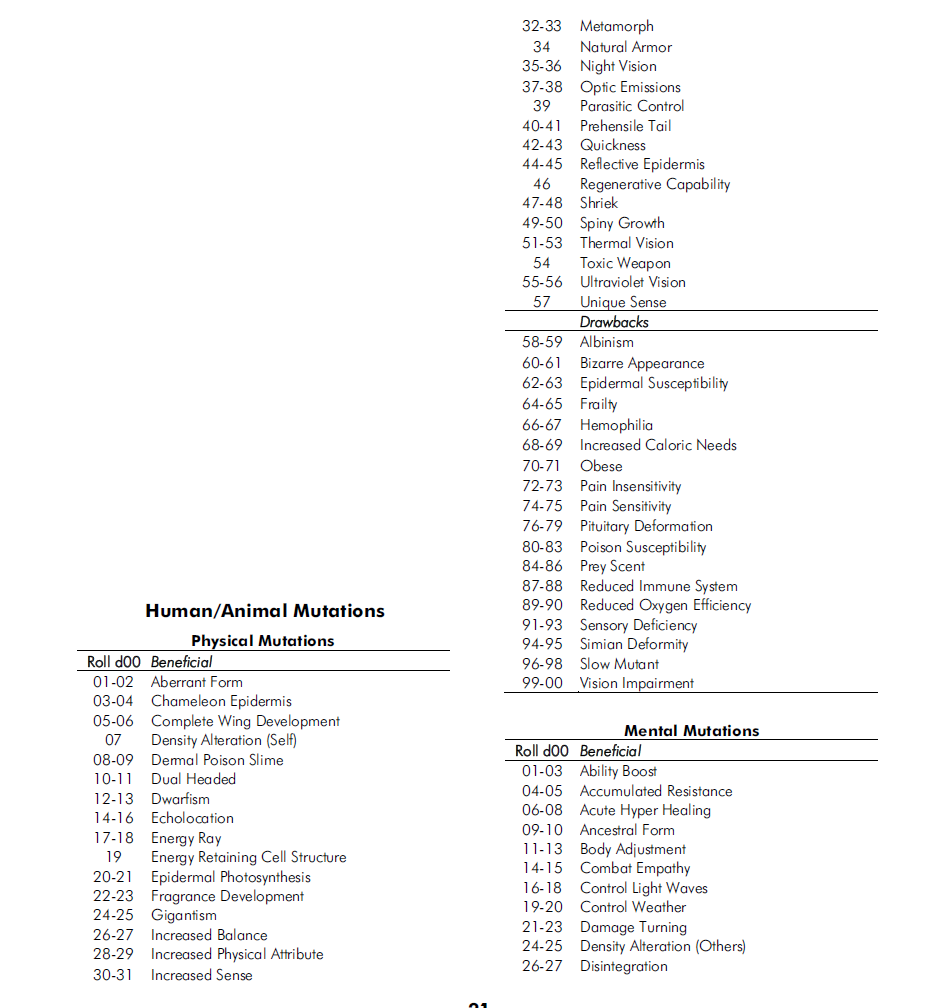
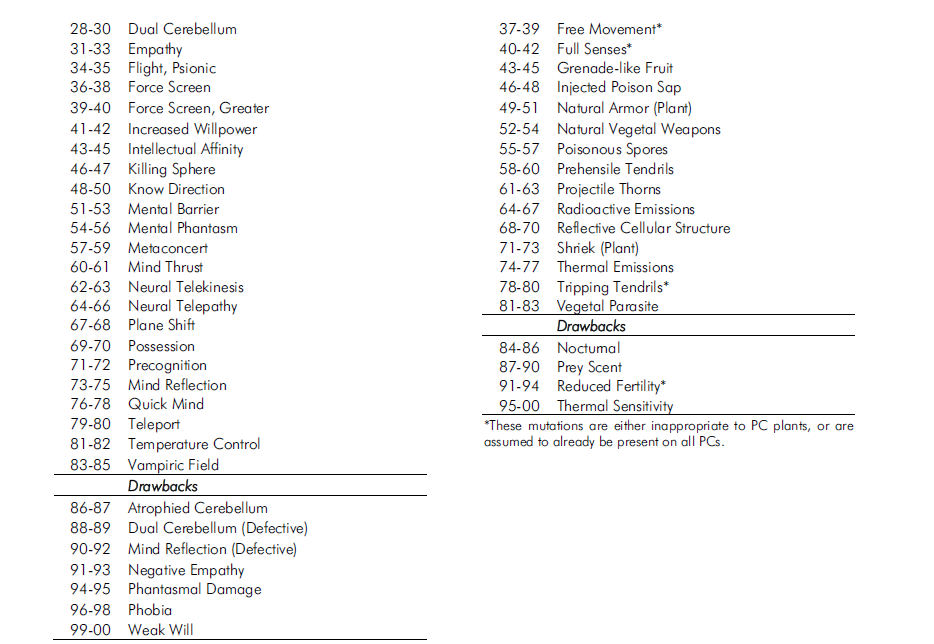
As you can see, you have a 43% chance of a drawback if you're rolling for a physical mutation, while mental mutations only give you a 15% chance of a drawback. Mutant plants have it pretty good with only a 17% chance of a drawback, and with certain mutations marked with an asterisk to denote the fact that they are already assumed to be a part of your character or inappropriate for PCs. So, if you're making a mutant dandelion, you're already assumed to be more than dandelion-sized and to have arms and legs and a face. Unfortunately, this does eliminate such wonderful concepts as potted plants with no means of locomotion who have to be hauled around by the rest of the group.

Any way, our yet to be named mutant animal character has 1 physical mutation and three mental mutations. Now it's time to roll them bones and see what we get!
77, 5, 65, 51
Our mutant animal has the physical drawback Pituitary Deformation and the three mental mutations Accumulated Resistance, Neural Telepathy and Mental Barrier. Now, let's find out what those actually mean!
Pituitary Deformation posted:
This defect indicates the pituitary gland of the mutant has been deformed by mutation, causing unnatural aging. A character with this defect appears much older than he really is, generally two to three times his actual age. Lifespan is also hindered by this deformation, resulting in a maximum natural lifespan of 40-50 years.
That's actually not too bad, assuming that in save vs. death-filled world of Mutant Future most creatures don't get to see the end of their natural lifespan. Our mutant animal is a bit on the wrinkly side and not very long-lived.
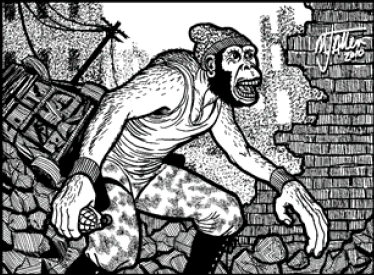
It could've been worse. This is the image for Simian Deformation.
Accumulated Resistance posted:
Through years of exposure to a certain substance (chemicals or radiation, for instance), or concentrated form of energy (such as heat, cold, or light) in the mutant’s environment, a resistance against said source has been accumulated, allowing the mutant to take more damage from one of these sources.
This mutation gives the mutant a hit point reserve equal to his total hit points. This hit point reserve is used to take damage from the substance he is resistant to before it begins to affect his regular pool of hit points. This separate pool heals in the same manner and at the same time as the character’s hit point pool, even if that rate is changed by other mutations such as acute hyper healing or body adjustment.
Okay, awesome. Since the mutation doesn't say how to determine the type of substance we have developed a resistance towards, I'm just going to pick radiation. Basking in the radioactive waves of the nuclear wasteland has given our character a resistance towards radiation, but also a nasty skin condition.
Neural Telepathy posted:
Using this ability, the mutant can connect his mind with another creature’s mind and communicate directly, even if the two creatures speak completely different languages or are of different species. The range of this ability is 30 feet.
Boring, yet practical. Combined with our higher than average Charisma, it is safe to assume that our character could easily charm even those creatures who are incapable of linguistic communication.
Mental Barrier posted:
Any mental attacks against this mutant receive a –4 penalty to their attack roll. A character with this mutation gains the ability to sense other creatures that have mental mutations at a range of 90 feet. This secondary ability does not require a roll.
Okay, so the ability to detect all creatures with mental mutations and an increased resistance against mental attacks? At this point we still don't know what our Willpower 6 amounts to, but I'm pretty sure this is a nice thing?
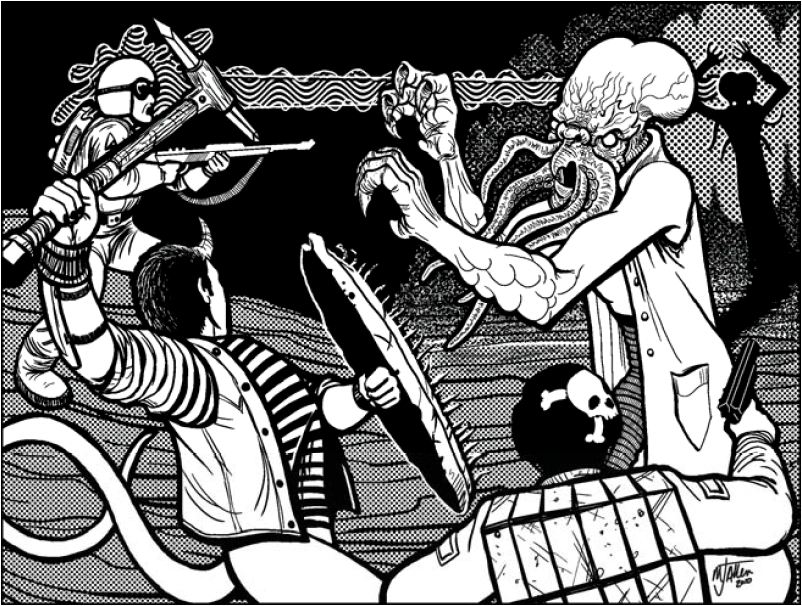
Out of nowhere, it's Nigthcrawler fighting a bunch of Mind Flayers!
So, we have a mutant animal with wrinkly skin, telepathy, increased resistance to radiation and the ability to detect all mental mutants. I'm thinking mutant naked mole-rat ! What would be a good name for this little guy? Would Gary Moleman be too obvious?
The only thing we're missing are his attack rolls and saving throws. Where are those to be found? They're not in the character creation section. I need to search forward twenty or so pages to find the table for saving throws by level, and another half a dozen pages to find the attack table.
This is basically the biggest problem with Mutant Future: in going for an old-school feel the designers have too closely emulated the unfriendly organization of information. Because of this, in order to actually create a character, you have to skip forward to a later section to actually find out the rest of your characters' abilities. Had we rolled any offensive poison or radiation mutations we would've also had to find the random poison and radiation charts in the encounter sections.
That's another thing: character creation is really wild in this game. With a bit of good luck, you can end up with a character with an attack that injects enemies with instant death poison on a failed save and a paltry 1d6 damage on a successful save. You could also end up with a radiation eye-beam that deals 10d6 radiation damage. Our character here is a pretty average character. On one hand, he doesn't really have great offensive powers, but taken into account that we could've ended up with a blind hemophiliac albino dwarf, he's pretty okay.
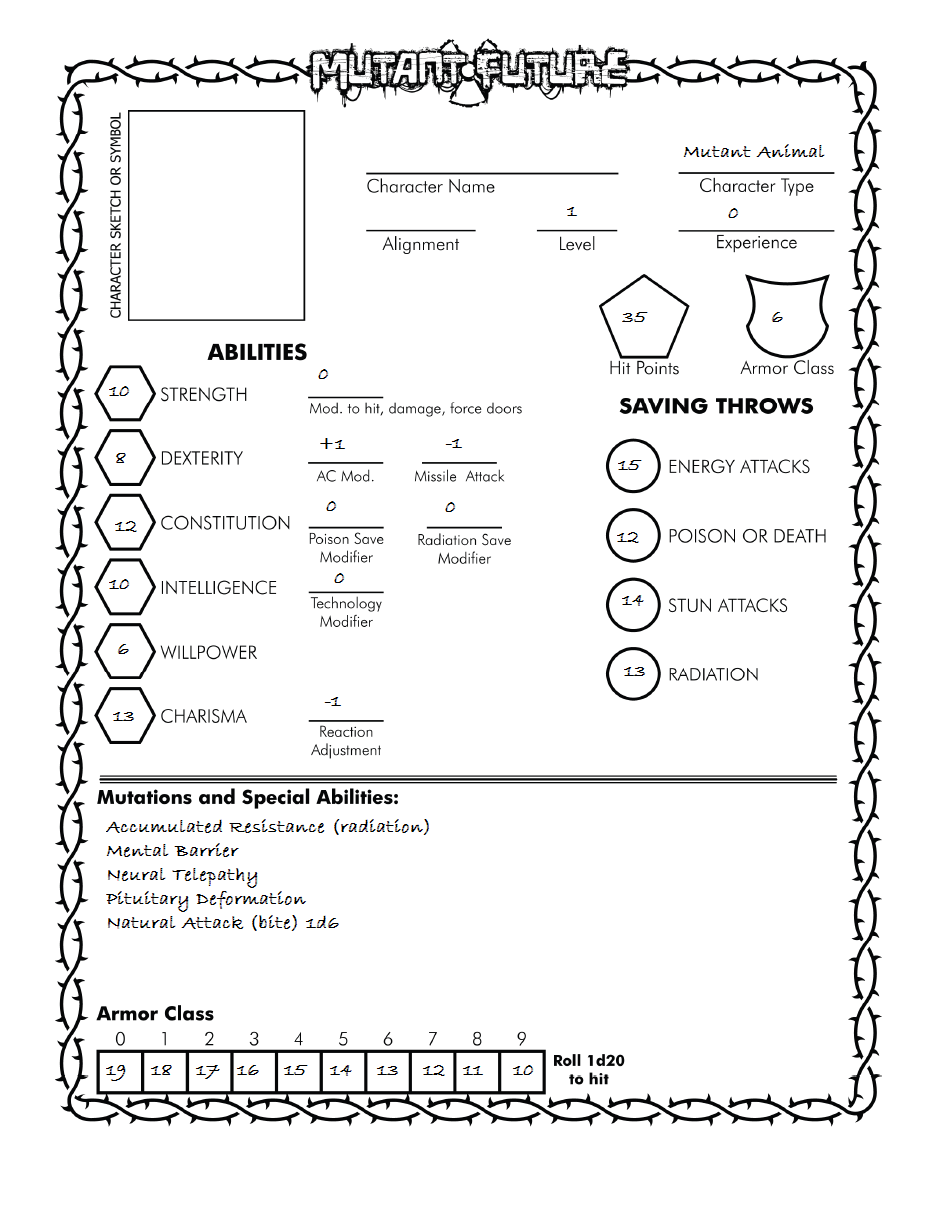
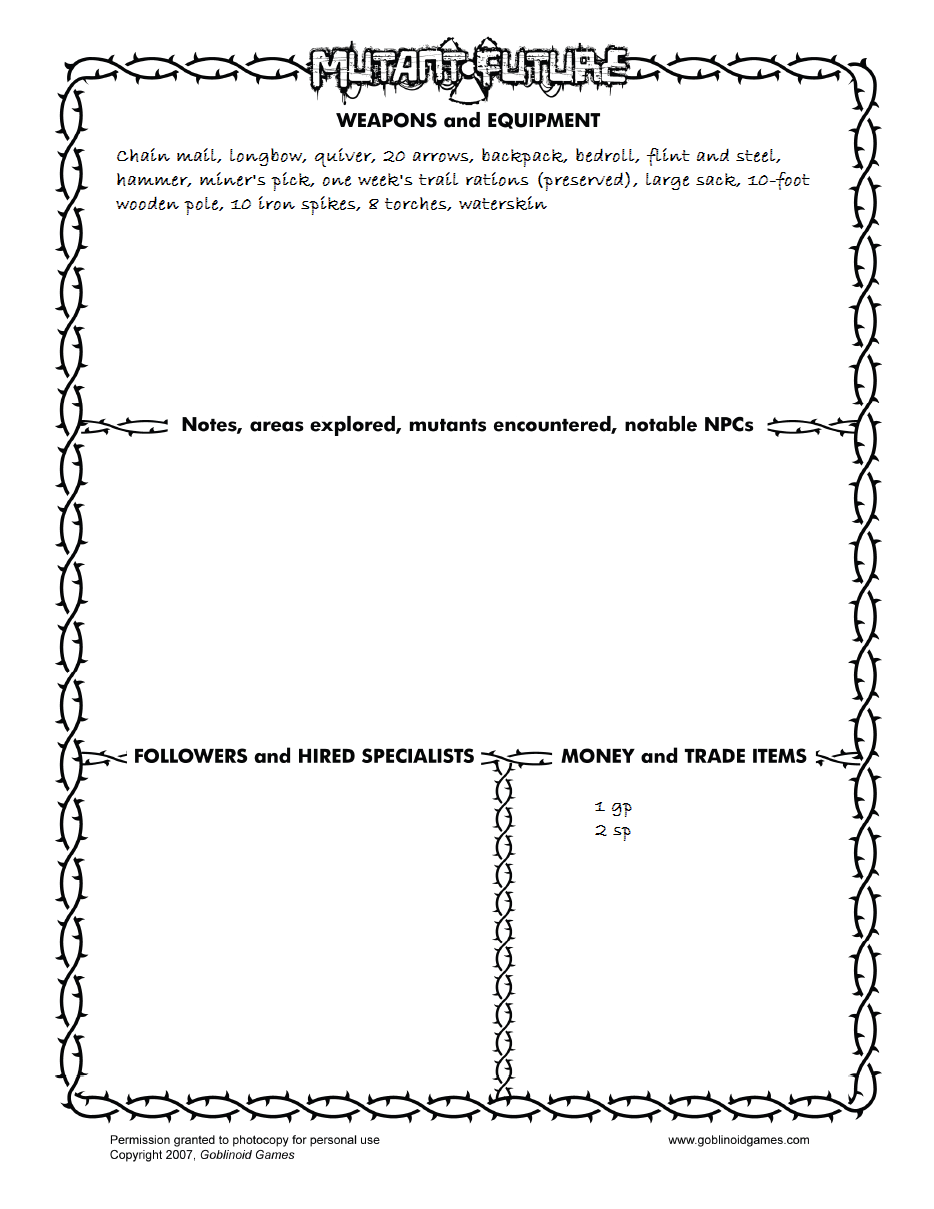
Our character, in all his glory!
Next time: Section 4: Adventuring Rules or: Rules for Adventuring in
Adventuring Rules or: Needlessly Complicated Rules for Technological Artifacts
Original SA post
Even at the risk of being overshadowed by Alien Rope Burn's take on Pathfinder (an endeavor which I fully support) I'm going to bite the bullet and continue my look at Mutant Future, so that I might be able to move on to something more novel at some point.

Mutant Future, Revised Edition. Part 4, Adventuring Rules or: Needlessly Complicated Rules for Technological Artifacts
You know, this section is by far the most tedious to go through. The adventuring rules have been lifted pretty much wholesale from Labyrinth Lord, which again took them straight from Basic D&D, and what with Evil Mastermind's take on Rules Cyclopedia and ZeeToo's look at Adventurer Conqueror King everyone should already have a pretty firm grasp of what sorts of things the rules entail: we have rules for adventuring in ruins (Mutant Future's version of dungeons), wilderness adventures (including rolls for foraging and hunting with the potential for death from eating anything found in the wilderness being left up to the Mutant Lord discretion), hiring retainers and mercenaries and awarding experience. As such, I won't be focusing on those things. Instead, I'll be looking at where it's at: technology rolls.
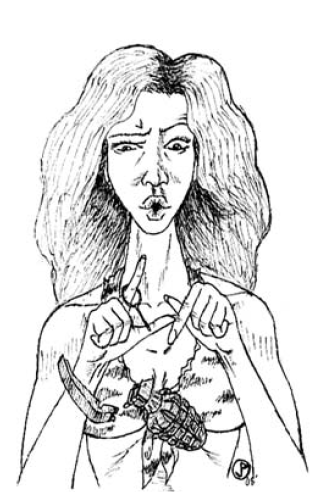
The result of a failed technology roll.
Unlike Basic D&D and its many clones, Mutant Future doesn't have magical items. Instead, it has technological artifacts, which are found randomly scattered throughout the wasteland, mostly in ruins but occasionally in the lairs of mutated beasties. Upon finding a technological artifact (which the Mutant Lord obviously generated by using the appropriate hoard class for the creature in question and rolled for randomly on a chart because GYGAXIAN NATURALISM!!!) the first thing to do is for the Mutant Lord to roll what condition the artifact is in. This is done by rolling on a d100 chart which gives the condition grade of said artifact. At worst, the artifact the PCs found is already in such terrible condition as to be nonfunctional.
But wait, there's more! After finding out what condition the artifact is in by rolling, you have to roll again against a probability determined by the artifact's condition to see whether it's actually functioning or not. The artifact's condition is only checked once, when it's found, so it's not like you have to check whether the artifact is working again every time you use it. So you have two rolls just to determine whether an artifact is working or not when you could just have one roll for no reason whatsoever.

Okay, I understand that aping these old legacy mechanics is part and parcel of the OSR, but in this case separating what is basically a Yes/No question into two separate rolls is completely unnecessary. If I could be bothered I'd put this through AnyDice to find out the actual probabilities of an artifact working just to reduce this needless rolling.
After you've found out whether the artifact you've found is even functional or not, you get to make your technology roll. All technological artifacts are divided into three complexity classes, with the least complex being stuff like energy weapons, pistols and the simplest of explosives, powered weapons and robots in between, and the most complex being stuff like medical equipment and computers. Each class not only has a base technology roll chance (modified by your character's Intelligence) as well as a base time to make one technology roll. These times are in hours, and as hanging out for too long in ruins is generally a bad idea, figuring out technology isn't something that you do during an excursion to a local ruin, it's something you do back in your home base.
This is what gets me about them though: the base chance to figure out an artifact of the lowest complexity class is 25% and takes 2 hours. A creature of average intellect may end up spending the better part of the day trying to figure out a fucking revolver. I guess the game's baseline technology level being medieval sort of justifies that, but it is just mystifying to think that nobody in the world of Mutant Future would've passed on the information that you need to pull the trigger on a pistol to get it to work.
A roll of 99 or 100 on the D% roll always means that you either damage the item or yourself in the process of trying to figure out the technological artifact. The image above shows one potential outcome, but there's a lot of further potential for hilarity: shooting yourself in the face while trying to figure out a gun, accidentally injecting yourself with a dose of a powerful anesthetic, activating the robot's "Kill all living things" mode, that sort of thing.
Next we have rules for repairing technology, which is labeled as an optional rule. Remember that nonfunctional slug-thrower you found after killing all those spidergoats who took your friend Timmy the Mutant with them? Well, if your Mutant Lord is feeling generous and your character is previously familiar with said artifact, you may be able to make a technology roll to try and repair it!
The technology rules are one of the places where it shows clearly that Mutant Future is trying to accommodate a number of different post-apocalyptic play-styles under one game: the idea of spending hours trying to figure out how all those cool technological gizmos you've found work doesn't chime well with the gonzo feel that the game puts forward in other places. Were I to run Mutant Future again in the future (and I really want to, because for all of its glaring flaws it's actually a really fun pick-up game for rolling a random bunch of mutants and going out to kill spidegoats with laser-guns) I would simply ignore these rules and just have the PCs have magical epiphanies about the technological artifacts in question. As a player it feels tedious having to roll whether or not I can actually use a goodie I found, and as a GM I don't generally like forcing my players into rolling endless series of binary Yes/No rolls just so we can get on with the fun and adventure.
Next time we'll be looking at the encounter rules, which bizarrely also includes rules for dying of dysentery and radiation.
